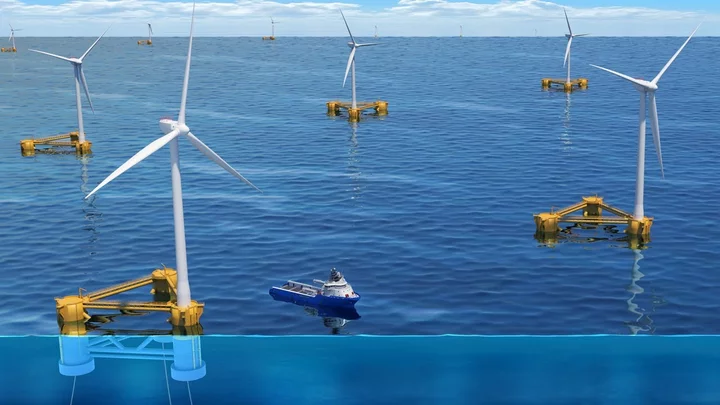Image via the U.S. Department of Energy.
###
Before the turbines comes the news coverage.
A story published Monday in Politico offers the latest look from a national publication at the nascent efforts to develop floating wind energy off the coast of Humboldt County — dramatic pause — “at a depth and scale never before attempted in the world.”
The piece notes that this $100 billion initiative (give or take some billions) could transform the peninsula and supercharge the region’s economy, creating hundreds of good-paying jobs while advancing state and federal goals to boost renewable energy production, though the story also outlines some of the major challenges and potential pitfalls of those efforts.
Noting Humboldt County’s low per-capita income and our history of economic boom-and-bust cycles, reporter Wes Venteicher says “a gust of optimism has arrived” on our shores. He quotes Rep. Jared Huffman, who says, “It’s a lot of good-paying jobs if we do it right. This can be part of lifting up the regional economy in a way that is better than anything to come along in decades.”
As previously reported here and elsewhere, Humboldt Bay hosts the only developed port for hundreds of miles in either direction that possesses both the channel depth and vertical clearance necessary to assemble and transport the massive turbines, which means we could eventually supply wind energy infrastructure up and down the West Coast.
Politico also runs through a list of challenges, including bureaucratic, economic, logistical and social, from impacts to tribal resources and fisheries to permitting amid “a widespread distrust of outsiders in a region where indiscriminate logging engendered deep resentment and where an illegal marijuana industry created a counterculture haven in the fog-shrouded mountains.”
As for our humble shores:
The land — which now hosts two seaweed farms, an oyster hatchery and temporary storage for freshly caught hagfish — would be transformed into an industrial terminal with up to 650,000 square feet of building space, lights mounted 150 feet in the air and giant cranes that crawl through the water on tank treads.
Venteicher rightly pinpoints the related challenge of sufficiently increasing electricity transmission capacity, noting that projects of this scale — sending up to 25 gigawatts of wind energy 270 miles south to the San Francisco Bay area — “have in the past taken more than a decade, and an overland line would need to run through environmentally sensitive areas as well as populated communities that may not welcome them.”
He adds, “An undersea cable is being considered, but deep underwater canyons and other features make that option logistically daunting.”
The full story can be accessed for free online with a simple click right here. Well worth a read.

CLICK TO MANAGE